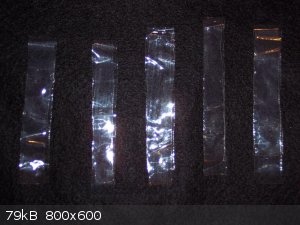
alive&kickin - 17-8-2015 at 04:30
Hello all. I've come across a plastic type film that seems to be resistant to a lot of different chemicals. The thing is, I don't have any real
strong acids, bases, solvents, etc. I was hoping that I could send some to someone that might be able to do some testing on it. I would also like to
get other opinions as to whether it is good or not. If things work out ok, then I can cut it into disks to send to other members here to seal
bottles that have plastic caps, for those that can't afford the more expensive storage bottles. Everyone knows those plastic caps don't ever last too
long. Let me know if someone is able and willing to help out their fellow scimad members. Here's a picture of the film I cut into strips for
testing.
If this is in the wrong place, please feel free to move it. Thanks everyone in advance for all the help.

[Edited on 17-8-2015 by alive&kickin]
[Edited on 17-8-2015 by alive&kickin]
kecskesajt - 17-8-2015 at 07:00
You could also burn it.If it burns fast,it is NC.It can be used as a binder in pyrotechnics.
macckone - 17-8-2015 at 07:00
Is it a polyimide film or a fluorinated polymer?
Or do you know the composition?
alive&kickin - 17-8-2015 at 07:45
kecskesajt, if it was NC, would it be resistant to acids and such? macckone, not sure what it is. I was hoping to find someone to test it, to see if
it's any good, and maybe venture a wild guess as to what it might be. Would probably be a long shot on that one though. If interested, let me know
and I'll get it in the mail asap.
macckone - 17-8-2015 at 08:51
Honestly it looks like polyimide. Polyimide is fairly resistant to weak
acids but can be damaged by alkalis and strong acids. It will also
be damaged by long exposure to water.
Does it resist organic solvents? If it is resistant to acetone that
narrows it down considerably. Also does it burn easily?
alive&kickin - 17-8-2015 at 11:37
kecskeajt and macckone, doesn't burn at all, just kind of melts, also acetone does nothing to it. Like I said, if someone wants to play around with
it and let everybody know what they find out, maybe that would be quicker than a few guesses on the part of this newbie.
macckone - 18-8-2015 at 12:12
OK that pretty much means it must be polyimide or fluorinated. With leaning toward fluorinated because most polyimides don't melt. Next test would
be to measure weight gain after several hours in boiling water. Polyimide will gain significant weight and may break down completely.
Texium - 18-8-2015 at 16:34
Where did you "come across" this substance? Did it come as a packaging material for a product, or did you find it just lying in the street?
alive&kickin - 18-8-2015 at 20:05
zts16, I got it from a friend whose father was a chemist that passed away. He's not into chemistry, so when he was cleaning out the attic of his
fathers house, he came across several items that he knew I might be interested in. This was one of them. macckone, I'll try boiling it like you
suggested, but I'm not sure my scale is going to be accurate enough for it. I'll give it a try though. Thanks for all the suggestions and help.
deltaH - 20-8-2015 at 12:39
Could it be that you stumbled onto some Nafion membrane, if so, NICE FIND!!!
alive&kickin - 23-8-2015 at 18:59
macckone, sorry it took so long, but when ma and grandma are canning in the kitchen, stay out of the way. I did like you said, boiled it in water for
4 hours, nothing, started with 1.1 grams, ended with 1.1 grams. Any other ideas?
Fantasma4500 - 26-8-2015 at 04:35
i'd just like to throw this in -- having looked into metal etching, nail polish seems somewhat resistant, although it contains nitrocellulose and some
other odd plastic, it seems to last even until the acid totally dries out, like 30% HCl with CuCl2*HCl complex
i have however seen tendencies of nitrocellulose hydrolyzing into nitric acid and the remainder somehow hydrolyzing, i'd guess when kept together with
hydrochloric acid for some time
i know personally that PTFE turns slightly clear before melting, and seems to be very hard to keep molten (i havent done much in it due to its
supertoxic nature, breathing in vapours may immediately make you faint, reference old plastic identification/safety handbook)
for figuring out metals, the most used method was observing the way the plastic would burn, whether it would crackle or soot, if it soots you could
suppose that it has some strong carbon-carbon bonds, like acetylene burning, where there isnt enough energy to break the tripple-bonds
i know PVC and PETeraphthalate can over time react with NaOH, PVC seems to somewhat crackle, where the other plastic will oftenly soften a slight
bit.. thumb rule is if a plastic is resistant to a strong base, then it wont be towards a strong acid
im getting bad at short replies..
macckone - 27-8-2015 at 17:17
It is probably some sort of fluorinated polymer.
PFA or similar, it could be nafion but there is no easy
way to tell the fluorinated polymers apart short of a
GC/MS and NMR.
